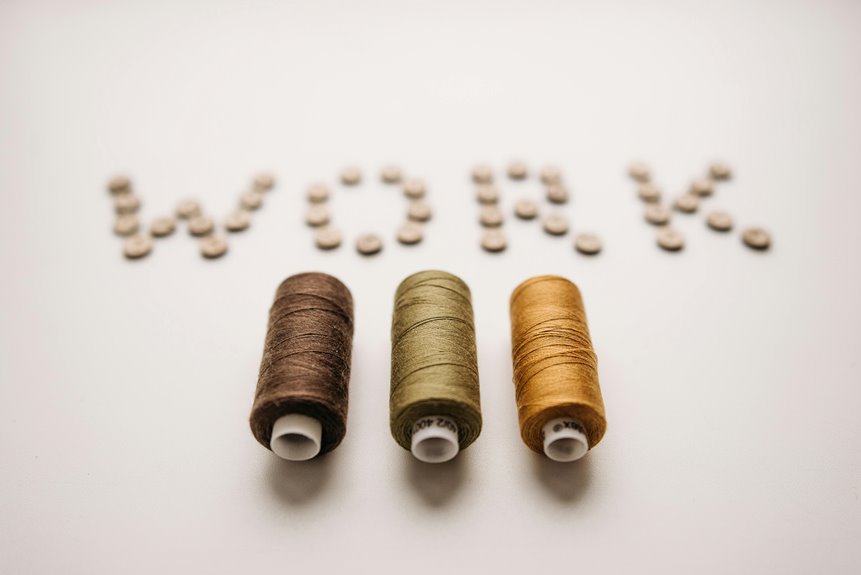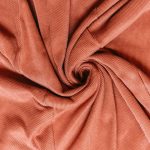You spell corduroy as cor-du-roy, with three clear syllables to keep it simple and correct. This fabric stands out for its distinctive ridged texture, combining softness with durability, making it both stylish and practical. Whether wide-wale or needlecord, corduroy’s tactile appeal adds character to your wardrobe. It carries a rich history and versatile fashion presence. If you want to explore how corduroy fits into your style and care routine, there’s plenty more to uncover.
Table of Contents
Key Takeaways
- Remember “corduroy” has three syllables: cor-du-roy, helping avoid misspellings like “cordury” or “cordoroy.”
- Corduroy features distinctive parallel ridges called wales, offering a unique tactile and visual fabric texture.
- It varies in wale width, from wide-wale for bold styles to needlecord for delicate garments.
- Originally durable workwear, corduroy evolved through fashion eras, gaining vintage and contemporary appeal.
- Proper care includes washing inside out in cold water and brushing to maintain its soft pile and durability.
Origins of the Word Corduroy
Although you might think the word “corduroy” simply refers to the fabric, its origins reveal a more interesting story.
When you dig into its history, you find that “corduroy” likely combines “cord” (meaning a type of fabric with raised ribs) and the French word “du roi,” which means “of the king.” This suggests a royal connection, though some debate exists about whether this is true or just a popular myth.
As you explore further, you see that corduroy has been around since the 18th century, prized for durability and comfort.
Understanding this background helps you appreciate why the word carries a sense of tradition, not just a description of a textile. It’s more than just a fabric—it has a story woven into its name.
Common Misspellings of Corduroy
You might often see corduroy spelled incorrectly with extra or missing letters, like “cordery” or “corduroie.”
Confusing the placement of vowels and consonants is a common mistake.
Let’s go over some tips to help you remember the correct spelling every time.
Frequent Spelling Errors
Where do most people slip up when spelling corduroy? You might confuse the order of letters or drop one altogether. A frequent error is writing “cordury” instead of “corduroy,” missing the vital “o.” Others mistakenly spell it as “cordaroy” or “cordoroy,” mixing up letter placement.
Sometimes, people write “corduroie,” adding an unnecessary “ie” at the end. These mistakes often happen because the word’s syllables aren’t obvious, and the “u” sound can be tricky.
To avoid these errors, remember that “corduroy” has three clear syllables: cor-du-roy. Breaking it down helps you spot missing or swapped letters. Paying attention to the middle “u” and the ending “roy” will keep your spelling accurate every time.
Common Letter Confusions
Mistakes like dropping the “o” or swapping letters often stem from confusing similar sounds and shapes in the word corduroy. You might accidentally write “cordury” by leaving out the middle “o,” or mix up the “r” and “d” to form “codruroy.”
The “u” and “o” vowels can also trip you up, leading to spellings like “cordurroy” or “cordoroy.” Since corduroy isn’t a word you use daily, these letter confusions are common. You might even reverse the “r” and “o” at the end, ending up with “corduroyr.”
Recognizing these typical mistakes helps you spot errors faster and avoid them. Being aware of how easily letters can switch or drop in corduroy improves your spelling accuracy.
Tips to Remember
How can you easily avoid common misspellings of corduroy? First, remember it starts with “cord,” like a rope or string. This helps prevent mixing it up with “card” or “cordar.”
Next, focus on the middle part: it’s “uro,” not “uroi” or “uroe.” The ending is “roy,” similar to “royal” without the “al.”
A quick tip: break the word into parts—cord + u + roy—and say it aloud slowly. Also, avoid doubling letters unnecessarily; it’s not “corduroyy” or “corduroi.”
Pronunciation Tips for Corduroy
You can make pronouncing “corduroy” easier by breaking it down into three syllables: cor-du-roy.
Watch out for common mistakes like stressing the wrong syllable or mixing up sounds.
Let’s go over these tips to get the pronunciation just right.
Breaking Down Syllables
Breaking down the word “corduroy” into syllables makes spelling it much easier. You can split it into three parts: “cor,” “du,” and “roy.” Saying each syllable slowly helps you hear the distinct sounds, so you won’t confuse the order of letters.
Focus first on “cor,” which sounds like “core.” Next, “du” sounds like “doo,” and finally, “roy” sounds like “roy,” just like the name. When you put these together—cor-du-roy—you’ll notice the rhythm and flow of the word.
Practice saying it aloud a few times, emphasizing each syllable. This approach strengthens your memory of the word’s spelling and pronunciation, making it less likely you’ll mix up letters or sounds later on. Give it a try!
Common Pronunciation Mistakes
Why do many people stumble when pronouncing “corduroy”? It’s often because they misplace the emphasis or confuse the vowel sounds. You might say “cor-DU-roy” instead of the correct “COR-du-roy.”
Also, some tend to soften or skip the middle “du” syllable, making it sound like “cor-roy,” which can confuse listeners. To get it right, focus on clearly pronouncing all three syllables and stressing the first one.
Remember, the “cord” part sounds like the word “cord,” not “card.” Practicing aloud helps, so try saying “COR-du-roy” slowly, then speed up as you get comfortable.
The Unique Texture of Corduroy Fabric
Corduroy stands out because of its distinctive ridged texture, which gives the fabric both visual appeal and a tactile dimension you can feel.
When you run your fingers over corduroy, you notice the parallel lines of raised cords or wales that create a soft yet structured surface. These ridges vary in width, from fine to wide, allowing you to choose a style that suits your preference.
The texture not only adds character but also enhances durability and warmth, making corduroy a popular choice for cooler weather.
You’ll find that its unique feel sets it apart from smoother fabrics, offering both comfort and a subtle, stylish edge in your wardrobe.
This tactile quality is a big part of corduroy’s lasting charm.
How Corduroy Is Made
You’ll find that corduroy starts with a special weaving process that creates its signature ribbed texture.
Then, fabric finishing methods add the final touch to make it soft and durable.
Let’s explore how these steps bring corduroy to life.
Weaving Process Techniques
The weaving process creates corduroy’s distinctive ridged texture by carefully interlacing warp and weft yarns.
You’ll start with a base fabric woven tightly using strong warp threads running lengthwise. Then, the weft yarns are woven over and under these warps to form the fabric’s foundation.
To achieve those characteristic ridges, raised pile yarns are introduced during weaving, creating vertical ribs called “wales.” These piles are woven in extra yarns that stand up from the base, spaced evenly apart.
The number of wales per inch varies, affecting the corduroy’s feel and appearance. By controlling yarn tension and weaving pattern, you get corduroy’s soft yet durable texture, perfect for clothing and upholstery.
This precise weaving technique is what sets corduroy apart from other fabrics.
Fabric Finishing Methods
Once the weaving process shapes the fabric’s distinctive ridges, finishing methods step in to enhance corduroy’s texture, durability, and appearance.
You’ll notice these steps bring out the fabric’s soft nap and vibrant look. First, the fabric undergoes brushing, which lifts the fibers to create corduroy’s signature plush feel.
Next, steaming sets the pile, ensuring those ridges stay upright and defined. Then, the fabric is sheared to trim any uneven fibers, giving a smooth, consistent finish.
Finally, it’s treated with a wash or softener to boost softness and reduce stiffness. Together, these techniques transform raw corduroy into the cozy, stylish material you love:
- Brushing to raise fibers
- Steaming to fix pile shape
- Shearing for uniform texture
- Washing to soften fabric
Different Types of Corduroy Weaves
Several distinct corduroy weaves give the fabric its unique texture and appearance.
When you look closer, you’ll notice variations based on the width and arrangement of the wales—the raised ridges that define corduroy.
Pinwale corduroy has very narrow wales, offering a softer, finer feel ideal for lightweight garments.
Wide-wale corduroy, in contrast, features thicker, more pronounced ridges, giving it a bold, rugged look perfect for jackets or trousers.
There’s also needlecord, which has even thinner wales than pinwale, often used for delicate or children’s clothing.
When you choose corduroy, the weave type directly influences its durability, warmth, and style, so picking the right one helps you match your needs whether for comfort or fashion impact.
Corduroy in Fashion History
Although corduroy originated as a durable fabric for workwear, it quickly found its way into mainstream fashion, transforming from utilitarian roots to a stylish staple.
You can spot corduroy making statements across decades, worn by everyone from workers to style icons. When you wear corduroy, you tap into its rich history:
- The 1920s: Favored by British aristocrats for sport and leisure.
- The 1970s: A symbol of counterculture with flared pants and jackets.
- The 1990s: Grunge bands embraced its rugged texture.
- Today: Designers mix vintage vibes with modern cuts.
Care and Maintenance of Corduroy Garments
Because corduroy has a unique texture and structure, you’ll need to handle it with care to keep it looking its best.
Always turn your corduroy garments inside out before washing to protect the pile from friction. Use cold water and opt for a gentle cycle or hand wash to prevent shrinkage and preserve softness. Avoid bleach and fabric softeners, as they can damage the fibers.
When drying, skip the dryer; instead, lay your corduroy flat or hang it to air dry to maintain its shape. If wrinkles appear, use a warm iron on the reverse side or steam gently.
Finally, brush your corduroy with a soft clothes brush to lift the pile and remove dust, keeping your garment fresh and vibrant longer.
Styling Tips for Corduroy Clothing
Corduroy offers at least three distinct textures and colors that can elevate your wardrobe instantly.
To style corduroy clothing effectively, focus on balancing its rich texture with simpler pieces. Here are some tips:
- Pair a deep brown corduroy jacket with a crisp white shirt and dark jeans for a classic look.
- Wear soft pastel corduroy pants with a neutral top to brighten your outfit gently.
- Layer a ribbed corduroy skirt with a tucked-in sweater and ankle boots for cozy fall vibes.
- Choose slim-fit corduroy trousers and combine them with a fitted blazer for polished casual wear.
These combinations highlight corduroy’s unique appeal while keeping your look fresh and modern.
Try mixing textures and shades to find your perfect corduroy style.
The Versatility of Corduroy in Home Decor
A fabric known for its durability and texture, corduroy brings warmth and character to any living space.
You can easily incorporate corduroy through cozy throw pillows that add a tactile element to your sofa. Consider corduroy slipcovers for chairs to create a relaxed yet stylish vibe.
Add warmth and texture with corduroy throw pillows and slipcovers for an inviting, stylish touch.
Its ribbed texture works well on curtains, offering both visual interest and insulation. Because corduroy comes in various colors, you can match it seamlessly with your existing decor.
It also pairs beautifully with other materials like wood and leather, enhancing a room’s depth. Whether you want a rustic or modern look, corduroy adapts effortlessly.
Frequently Asked Questions
Is Corduroy Fabric Environmentally Friendly?
You might find corduroy’s environmental impact depends on its material—cotton corduroy uses water and pesticides, but recycled or organic versions are greener. So, choosing sustainably made corduroy helps reduce its environmental footprint.
Can Corduroy Be Used for Upholstery?
You know, “a stitch in time saves nine.” You can definitely use corduroy for upholstery; it’s durable and adds cozy texture. Just make sure to choose a heavy-weight fabric for lasting comfort and style.
How Durable Is Corduroy Compared to Denim?
You’ll find corduroy less durable than denim because its raised ridges wear down faster. Denim’s tighter weave makes it tougher, so if you want long-lasting fabric, denim’s usually the better choice for heavy use.
What Are the Best Seasons to Wear Corduroy?
They say, “Dress for the weather you want.” You’ll find corduroy perfect for fall and winter since it keeps you warm and cozy. Its thick texture isn’t ideal for hot summer days, though.
Are There Synthetic Alternatives to Traditional Corduroy?
Yes, you’ll find synthetic alternatives to traditional corduroy made from polyester or nylon blends. These fabrics mimic the ribbed texture while offering durability, wrinkle resistance, and sometimes moisture-wicking properties for easier care and comfort.
- DIY Ombre Tie-Dye: A Simple Guide for a Faded Look - July 13, 2025
- Ombre Tie-Dye Technique: How to Create a Gradient Effect - July 13, 2025
- How to Do the Crumple Tie-Dye Technique: A Step-by-Step Tutorial - July 13, 2025







